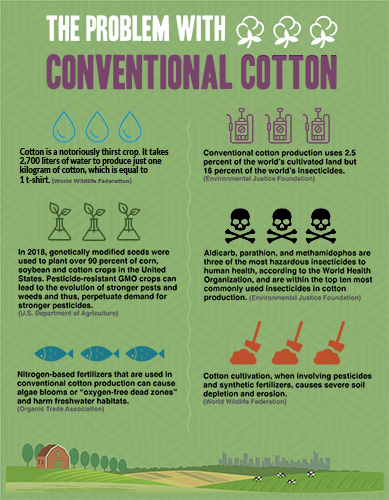
Green America has long called for a large-scale transition from conventional agriculture to a regenerative model that sequesters carbon as we work to reverse the climate crisis. Through our green economy campaigns like Soil SuperHeroes and Climate Victory Gardens, and our Center for Sustainability Solutions’ Soil Carbon Index—the world’s first agricultural standard for soil health—we are leveraging the power of farmers, food companies, scientists, consumers, and other stakeholders to demand change and transform the system.
Regeneration is for every facet of society that involves cultivating the land, and that includes the production of fibers, fuel, and forests. Our Toxic Textiles report uncovered that textiles manufacturing accounts for 20 percent of industrial water pollution and the fast fashion industry is responsible for eight percent of global greenhouse emissions, according to the sustainability metrics company Quantis.
Can you imagine if one of the dominant fibers used to make our clothes was grown with techniques so sustainable and in concert with nature that its production helped the planet? That’s the vision regenerative cotton farming presents to the world.

To view the full-sized infographic, click here.
Memorably called “the fabric of our lives” by the industry, cotton is the most commonly used fabric for clothing in the world, and it grows in over 100 countries and accounts for 2.5 percent of the globe’s cultivated land. Humans have been cultivating cotton for over 7,000 years and its soft, pliable properties have made it popular for clothes. But, unsustainable practices like the use of pesticides, nitrogen-based fertilizers, and genetically modified seeds have contributed to the climate crisis.
Some of the world’s largest cotton-producers are in precarious situations. India, the world’s second largest cotton producer, is experiencing severe water scarcity exacerbated by the cotton industry, according to the Water Footprint Network. And China, the world’s leading cotton producer, is struggling to manage a growing population of mirid bugs—a major pest that has been thriving under the country’s warming temperatures and feasting on cotton.
With a commitment to the soil where cotton grows, we can reverse environmental damage and quell associated threats to communities. By ditching mechanization, pesticides, an chemical fertilizers for no-till methods, animal integration, and composting on an industry-wide scale, we can better protect farmers and reduce chemical pollution. These methods could even quench cotton’s thirst, since nurturing soil health is proven to improve the crop’s water retention.
Molecular biologist and California State University adjunct professor David C. Johnson, Ph.D, has developed an advanced soil health management system that works for cotton and anything else with roots in the ground, called Biologically Enhanced Agricultural Management (BEAM). This practice replenishes soil microbes in soil that has been degraded through conventional farming methods. Johnson is a member of Green America’s Carbon Farming Network, and is working closely with us on scalinghis solutions.
“The Carbon Farming Innovation Network is engaging with apparel companies and farmers who supply them that are advancing regenerative agriculture,” says Mary Johnson [no relation], director of that network at Green America’s Center for Sustainable Solutions.
Though US apparel companies are still in the earliest stages of bringing regenerative cotton products to market, breakthroughs are happening. In September 2018, The North Face unveiled its Cali Wool Collection, which showcases clothing and accessories produced from regenerative methods on California farms. In 2019, Wrangler announced a new line of denim jeans that, though not grown regeneratively, use 30 percent recycled cotton and eliminate 99 percent of water used in the dyeing process.
Green America looks forward to expanding our work with apparel companies for a regenerative future. To help us jump-start that, reach out to your favorite clothing companies and ask them to adopt the Soil Carbon Index.







